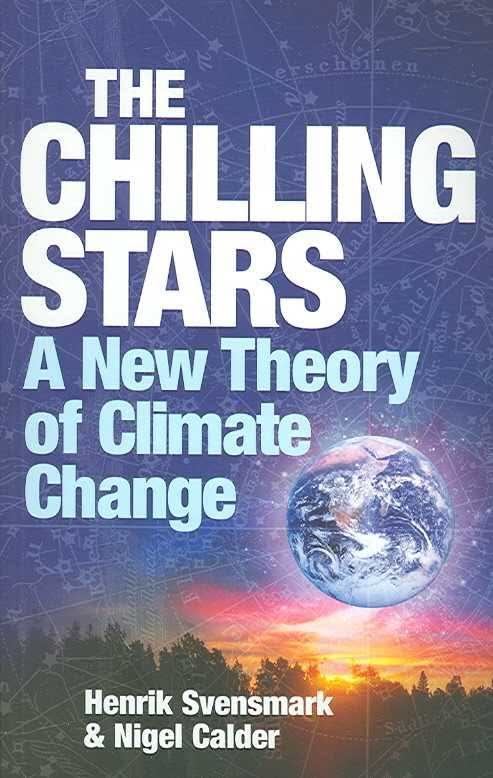8 /10 1 Votes8
Language English Originally published 2007 | 4/5 Goodreads ISBN 1-84046-815-7 | |||||||||||||||||||||||||||||||||
 | ||||||||||||||||||||||||||||||||||
Similar Nigel Calder books, Climate change books, Non-fiction books | ||||||||||||||||||||||||||||||||||
The Chilling Stars is a non-fiction book about the possible causes and effects of global climate change by Henrik Svensmark and Nigel Calder. The paperback version was published by Totem Books on March 19, 2003. An updated version titled The Chilling Stars: A New Theory of Climate Change was published in 2007. Svensmark is otherwise known as a Danish physicist and professor while Calder has worked as a science journalist.
Contents
The authors argue that cloud cover changes caused by variations in cosmic rays are a major contributor to global temperature increases, and they state that human influences have been exaggerated.
Contents and background
The authors describe a cross-disciplinary theory that takes in elements of cosmology, particle physics, paleo-climatology, and meteorology. They label their concept 'cosmoclimatology', and they attempt to look back through prior climate trends such as the Medieval Warm Period and the Little Ice Age. They detail what they view as a close correlation between the rate of cosmic rays reaching the earth, which vary based on electromagnetic fluctuation on the sun's surface, and earth's temperature.
They write how the solar magnetic field grew over twice as strong as before over the 20th century, and they peg this as a primary driver of the approximately 0.6 °C warming over that time. Specifically, they state that less cosmic rays cause less clouds to form and thus the climate becomes hotter, given that the individual water droplets that make up clouds collect when cosmic particles turn water into ions.
Reviews
The online magazine londonbookreview.com remarked, "For those who believe that the argument about the causes of climate change have been settled may find this a difficult book to read. But those who retain an open mind may find this an interesting read, even if it is only to confirm that the science is far from being settled."
Michael R. Fox, Ph.D. wrote for the Grassroot Institute of Hawaii that the book "is a must read if you want to better understand the real environment around you and unravel the twisted claims of the global warming fiasco."
Scientists have also published reviews of Svensmark et al.'s work, which this book promotes to a broader audience. In 2012, Lockwood authored a review of efforts by scientists to learn from Svensmark and others' contribution to climate science (which is outlined in this book). This effort found that his claims about global climate change are greatly exaggerated. They also found that his work is making an important contribution to scientists' understanding of regional climate variations.
"The cloud-cosmic ray suggestion increasingly fails to match observations. The correlation between the solar-cycle variation and global cloud-cover estimates has degraded rapidly in the more recent data (Gray et al. 2010). For each piece of evidence in its favour, an equal or greater number of studies fail to find the effect ....
"The recent evolution of solar cycle 24 indicates that the Sun may well be following such a trajectory (Owens et al. 2011). Feulner and Rahmstorf (2010) and Jones et al. (2012) have used GCMs and EBMs to predict that this will offset anthropogenically rising global temperatures by no more than about 0.2 °C in the year 2100, relative to what would happen if the solar output remained constant. Similarly, Lean and Rind (2009) find that the solar decline would delay the arrival at a given temperature level by no more than about 5 years. Thus, these predictions show that continued solar decline will do little to alleviate anthropogenically driven global warming. However, the decline should do much to end the debate about the fraction of global warming that can be attributed to solar change. For the first time since about 1900, long-term solar and anthropogenic trends are now in opposite directions. Non-robust fits will fail sooner rather than later because of the change in solar behaviour. Thus, the next few years will give us much better estimates of the solar contribution to both global and regional climate change."
Another example of scientific review of the contents of this book was published by a joint Spanish/Japanese collaboration of solar ray/astrophysics experts. Using data gathered in the last 10 years by the International Satellite Cloud Climatology Project using new satellite-based instruments that can measure cloud cover from space, they set out to investigate the claims outlined in this book. They found that the change in global cloud cover is closely correlated with El Niño–Southern Oscillation and uncorrelated with solar rays. They concluded:
"An analysis of the first decade of monthly time-scale MODIS cloud anomalies has shown that neither variations in TSI emissions or the GCR flux are dominantly responsible for cloud variability at global or local (geographic) scales at any altitude level. Although correlation analysis suggests that some statistically significant correlations between cloud variability and TSI/GCR variations are present, further investigation of these relationships revealed that such associations either broke down during the data period or were likely connected to internal climate variability and not to solar activity."
